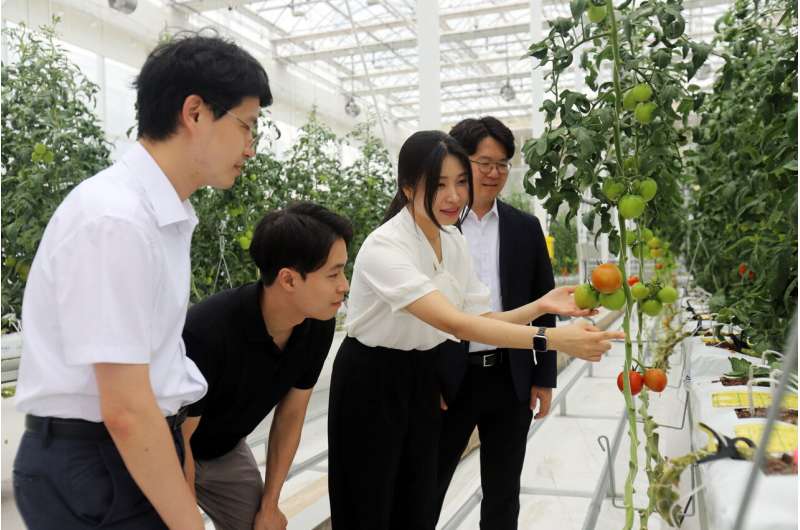
A new integrated energy platform using multiple renewable energy sources has been successfully developed and tested, enabling energy independence and carbon reduction in agriculture. Compared to conventional greenhouse systems, it reduces CO₂ emissions by over 50% and cuts operating costs by more than one-third.
The Korea Institute of Machinery and Materials (KIMM), under the National Research Council of Science and Technology, has developed a hydrogen-fueled combined heat and power (CHP) system that integrates hydrogen fuel cells, solar thermal collectors, heat pumps, and adsorption chillers. The system has been successfully deployed in a 660-square-meter smart greenhouse.
The system combines PEM fuel cells, air-source heat pumps, solar collectors, and adsorption chillers to generate electricity and reuse the waste heat for cooling and heating. During the day, it mainly uses solar energy, while at night or during low sunlight hours, it operates by combining the fuel cell and heat pump, efficiently producing and supplying energy depending on the season and time of day.
Conventional greenhouse systems typically rely on a single energy source like solar or geothermal, making them vulnerable to weather changes and seasonal efficiency drops. Fuel cell systems capable of utilizing waste heat have mostly been limited to buildings or industrial applications.
KIMM’s system addresses these limitations by combining multiple renewable energy sources. In winter, heat from the fuel cells and solar collectors is converted into hot water to warm the greenhouse. In summer, the heat drives the adsorption chiller to produce cold water for cooling. Additionally, the air-source heat pump supports heating and cooling during extreme weather such as heat waves or cold snaps.
-

On-site demonstration of the greenhouse Hydrogen-fueled combined heat and power system (Rural Development Administration’s National Institute of Agricultural Sciences, Jeonju, Korea). Credit: Korea Institute of Machinery and Materials (KIMM)
-

On-site demonstration of the greenhouse Hydrogen-fueled combined heat and power system (Rural Development Administration’s National Institute of Agricultural Sciences, Jeonju, Korea). Credit: Korea Institute of Machinery and Materials (KIMM)
The team designed an integrated control system to optimize energy flows between heat sources, minimizing interdependence while maximizing energy stability. Innovations include a fuel cell with adjustable output, a heat pump that generates more than 5.2 times its input electricity in heat, solar collectors optimized for daytime operation, and real-time monitoring and control of the entire system.
An adsorption chiller capable of producing chilled water at lower heat source temperatures (65–70°C), compared to conventional absorption chillers, was used. Heat from the solar collectors and fuel cells is stored in a thermal storage tank and used to supply cooling energy to the greenhouse.
The system has demonstrated a 36.5% reduction in operating costs and a 58.1% cut in CO₂ emissions compared to existing greenhouse heat pump systems. In a 660㎡ demonstration greenhouse at the Rural Development Administration’s National Institute of Agricultural Sciences in Jeonju, tomatoes have been successfully cultivated for over six months.
Dr. Sang Min Lee, head of KIMM’s Future Agriculture and Biosystems Research Engineering Center, said, “This system enables stable energy production regardless of external weather conditions and is ideal for Korea’s environment, where energy demands fluctuate greatly between seasons. It is the first case of applying hydrogen fuel cells to smart farming, making a significant contribution to achieving energy self-sufficiency in greenhouse agriculture.”
Dr. Jin Young Park, senior researcher at the Department of Carbon-free Power Generation, added, “We achieved high energy efficiency and stability compared to conventional systems. The electricity generated by the fuel cell is used directly in the greenhouse, improving economic viability.”
Earlier this year, KIMM established the Future Agricultural Bioengineering Division to lead the development of core technologies for agriculture and secure global leadership in the field. The division is now actively developing advanced technologies in agricultural energy, resource management, and digital transformation.
The hydrogen-fueled CHP system was jointly developed by KIMM’s Future Agricultural Bioengineering Division and Zero-Carbon Power Laboratory, with support from Korea’s national green hydrogen and smart farm innovation programs.
Provided by
National Research Council of Science and Technology
Citation:
New smart, carbon-free agriculture system is powered by renewable energy (2025, July 16)
retrieved 16 July 2025
from https://phys.org/news/2025-07-smart-carbon-free-agriculture-powered.html
This document is subject to copyright. Apart from any fair dealing for the purpose of private study or research, no
part may be reproduced without the written permission. The content is provided for information purposes only.
